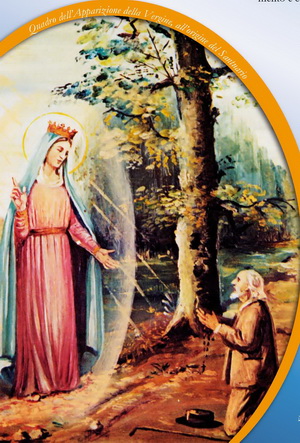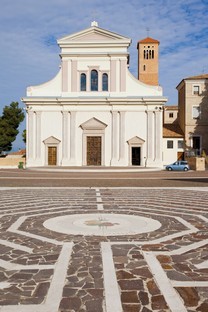L’imponente Santuario della Madonna dei Miracolirappresenta il “polmone spirituale” dell’Arcidiocesi di Chieti-Vasto. Il Santuario, retto dal 1925 dai monaci Benedettini, si erge sul luogo dove, secondo la leggenda, sarebbe apparsa la Madonna. Si narra, infatti, che l’11 giugno 1526, un contadino di Pollutri, Alessandro Muzio, si avviava recitando il rosario verso il proprio campo per constatare i danni causati dalla violenta grandinata che poco prima si era abbattuta sulla zona. Udito il suono d ella campana che annunziava in paese la celebrazione della messa, si inginocchiò. Fu a quel punto che nei pressi di un querceto apparve la Madonna per rivelargli che la tempesta del giorno precedente era la conseguenza dello sdegno di Dio “per i molti peccati dei suoi compaesani” e lo ammonì ad indurre costoro al rispetto del riposo festivo “onde evitare il castigo della grandine e dei venti rovinosi”. Sul luogo sorse, l’anno stesso dell’apparizione della Vergine, una piccola cappella rurale che poi venne man mano ampliata fino ad assumere le forme attuali. La facciata oggi si presenta in stile rinascimentale, con tre portali lignei e una cupola alta 37 metri. L’interno è a croce latina. Nella cripta è visibile il punto esatto nel qu
ella campana che annunziava in paese la celebrazione della messa, si inginocchiò. Fu a quel punto che nei pressi di un querceto apparve la Madonna per rivelargli che la tempesta del giorno precedente era la conseguenza dello sdegno di Dio “per i molti peccati dei suoi compaesani” e lo ammonì ad indurre costoro al rispetto del riposo festivo “onde evitare il castigo della grandine e dei venti rovinosi”. Sul luogo sorse, l’anno stesso dell’apparizione della Vergine, una piccola cappella rurale che poi venne man mano ampliata fino ad assumere le forme attuali. La facciata oggi si presenta in stile rinascimentale, con tre portali lignei e una cupola alta 37 metri. L’interno è a croce latina. Nella cripta è visibile il punto esatto nel qu ale secondo la tradizione avvenne l’apparizione. Oltre al pregevole dipinto murale che raffigura la Madonna dei Miracoli col beato Muzio, si può ammirare un sontuoso altare ligneo elegantemente intagliato, dipinto in oro con effetto marmorizzato. Il monastero attiguo alla chiesa ospita una ricca biblioteca che raccoglie ben 70.000 volumi tra cui preziosi codici e miniature della tradizione benedettina italiana medievale. Tutt’oggi il Santuario, in particolare nei giorni della festa (9-11 giugno), richiama una grande folla di pellegrini che in attesa della “grazia” richiesta alla Vergine fino a pochi anni fa trascorreva la notte all’interno della chiesa, dove oggi è anche accessibile la sala degli ex-voto dell’800 e dei primi del ‘900.
ale secondo la tradizione avvenne l’apparizione. Oltre al pregevole dipinto murale che raffigura la Madonna dei Miracoli col beato Muzio, si può ammirare un sontuoso altare ligneo elegantemente intagliato, dipinto in oro con effetto marmorizzato. Il monastero attiguo alla chiesa ospita una ricca biblioteca che raccoglie ben 70.000 volumi tra cui preziosi codici e miniature della tradizione benedettina italiana medievale. Tutt’oggi il Santuario, in particolare nei giorni della festa (9-11 giugno), richiama una grande folla di pellegrini che in attesa della “grazia” richiesta alla Vergine fino a pochi anni fa trascorreva la notte all’interno della chiesa, dove oggi è anche accessibile la sala degli ex-voto dell’800 e dei primi del ‘900.
Le forme devozionali di matrice popolare che in passato si svolgevano nel Santuario hanno trovato importante collocazione in ambito letterario e pittorico. Il vate Gabriele D’Annunzione rimase profondamente colpito tanto da appellarle come “barbariche” nella sua opera Il trionfo della morte. A questo primitivo mondo di contadini e pastori il pittore Francesco Paolo Michetti dedica invece un’attenzione quasi da antropologo e studioso delle tradizioni che trova la sua migliore espressione nella processione che egli dipinse nel quadro Gli Storpi (1900).
Shrine of Our Lady of Miracles – Casalbordino (Ch)
The impressive Sanctuary of Our Lady of Miracles is the “spiritual lung” of the Archdiocese of Chieti-Vasto. The Sanctuary, ruled since 1925 by Benedictine monks, stands on the site where according to legend, the Virgin appeared. The story goes, that on 11 June 1526, a farmer from Pollutri, Alessandro Muzio, we started praying the rosary to his own field to see the damage caused by the violent hailstorm that just before had hit the area. Hearing the sound of the bell announcing the celebration of Mass in the country, it knelt down. It was then that an oak grove near the Virgin Mary appeared to reveal that the previous day’s storm was the consequence of the wrath of God “for the many sins of his countrymen,” and admonished him to lead them to the respect for Sunday rest “in order avoid the punishment of the hail and winds ruinous. ” The place was built, the year of the apparition of the Virgin, a small rural chapel which was then gradually expanded until it took its present shape. The facade now appears in the Renaissance style, with three wooden portals and a dome 37 meters high. The interior has a Latin cross. In the crypt you can see the exact spot where the apparition took place according to tradition. In addition to the valuable mural depicting the Blessed Virgin of Miracles by Muzio, you can enjoy a sumptuous elegantly carved wooden altar, painted in gold with marble effect. The monastery adjoining the church contains a very rich library containing 70,000 volumes, including codes and precious miniatures of the medieval Italian Benedictine tradition. Even today the shrine, especially in the days of the festival (9-11 June), draws a huge crowd of pilgrims waiting for the “grace” to the Virgin request until a few years ago he spent the night inside the church, where Today the hall is also available ex-voto ‘800 and early ‘900.
The matrix forms of popular devotion in the past were held in the Sanctuary have found important place in literature and painting. The Gabriele D’Annunzio was deeply impressed by both appellarle as “barbaric” in his book The Triumph of Death. In this primitive world of peasants and shepherds the painter Francesco Paolo Michetti instead devotes most attention from anthropologist and scholar of the tradition that finds its best expression in the procession, he painted under The Cripples (1900).


